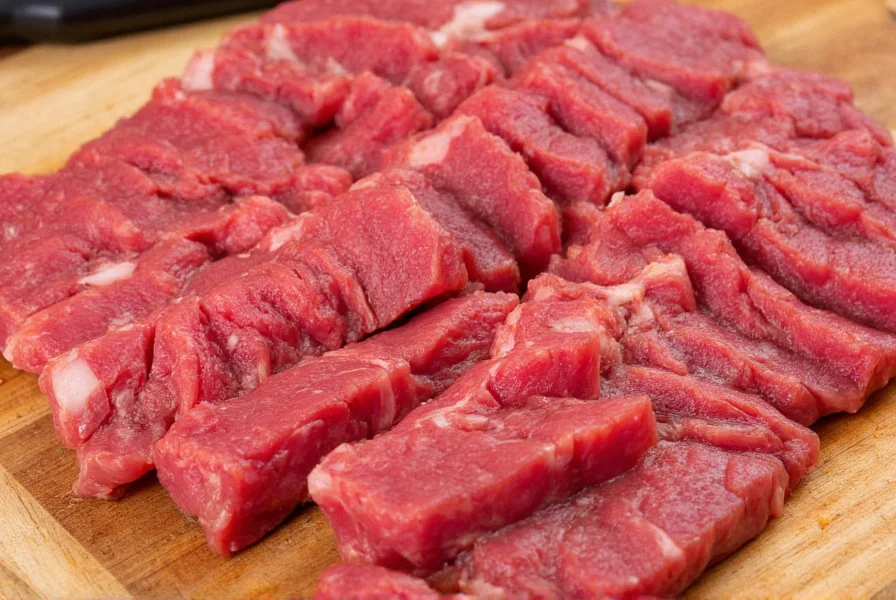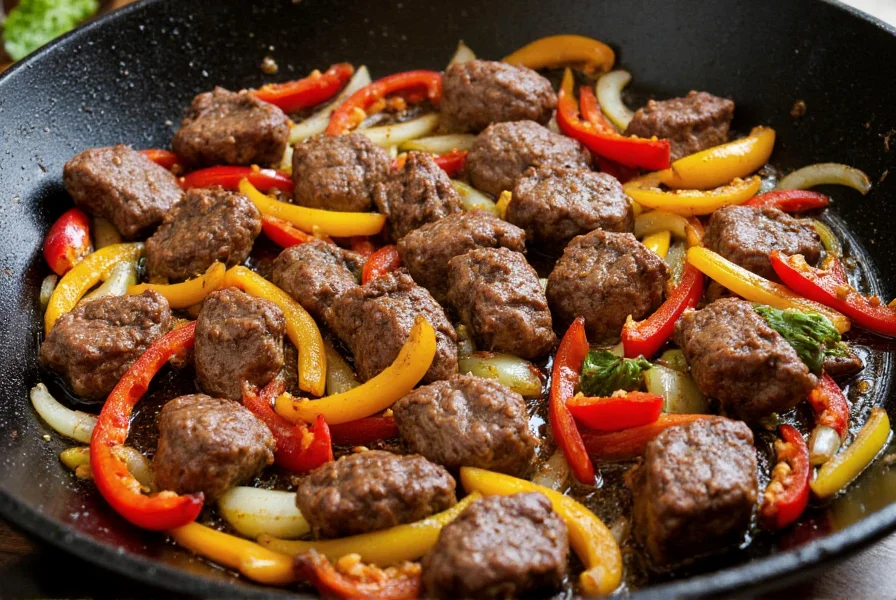When preparing authentic pepper steak, selecting the right cut of meat makes all the difference between a tough, chewy disappointment and a restaurant-quality dish. Flank steak stands as the top recommendation for pepper steak meat due to its distinctive grain structure that, when sliced properly against the grain after cooking, delivers exceptional tenderness. This lean cut comes from the abdominal muscles of the cow and features pronounced marbling that enhances flavor without excessive fat.
Sirloin, particularly top sirloin, serves as an excellent alternative for pepper steak preparation. With slightly more marbling than flank steak, sirloin offers a buttery texture while maintaining the firmness needed for stir-frying. The key to success with either cut lies in proper preparation techniques that maximize tenderness without compromising the meat's ability to sear properly.
| Meat Cut | Tenderness Level | Flavor Profile | Best Cooking Method | Price Range (per lb) |
|---|---|---|---|---|
| Flank Steak | Moderate (becomes tender when sliced correctly) | Rich, beefy, slightly robust | High-heat stir-fry, sliced thin against grain | $8-12 |
| Top Sirloin | Naturally tender | Buttery, mild beef flavor | Quick sear, medium-rare to medium | $10-14 |
| Skirt Steak | Variable (requires careful slicing) | Intensely beefy, robust | Very high heat, extremely quick cook | $7-10 |
| Ribeye | Very tender | Rich, marbled, luxurious | Not recommended for traditional pepper steak | $14-18 |
Understanding pepper steak meat selection involves recognizing how different cuts interact with the cooking process. The high-heat stir-frying method used in pepper steak preparation demands meat that can withstand quick cooking without becoming tough. Flank steak's long muscle fibers respond exceptionally well to marinades containing acidic components like vinegar or citrus juice, which help break down connective tissues. For optimal results when using flank steak for pepper steak, slice the raw meat across the grain into thin strips (about 1/4 inch thick) before marinating.
Professional chefs preparing pepper steak meat follow specific preparation techniques that home cooks can easily replicate. The velveting method, common in Chinese cuisine, involves treating the meat with a mixture of cornstarch, egg white, and rice wine before cooking. This creates a protective coating that seals in juices during the high-heat cooking process. For authentic pepper steak meat preparation, combine 1 tablespoon cornstarch, 1 egg white, and 1 teaspoon rice wine per pound of sliced beef, then let it rest for 20-30 minutes before cooking.
Marinating time significantly impacts the final texture of your pepper steak. While flank steak benefits from 2-4 hours of marinating, sirloin requires less time (30-60 minutes) to avoid becoming mushy. Over-marinating flank steak beyond 8 hours can lead to a mealy texture as the acid in the marinade begins to break down the meat too much. The ideal pepper steak meat marinade includes soy sauce, garlic, ginger, and a touch of sugar to balance flavors and promote caramelization during cooking.
When cooking pepper steak, proper heat management proves crucial for achieving restaurant-quality results. Your pan or wok must be smoking hot before adding the meat—this ensures proper searing rather than steaming. Cook the pepper steak meat in batches to avoid overcrowding, which lowers the pan temperature and prevents proper browning. For the best texture, cook each batch for just 1-2 minutes until the exterior is browned but the interior remains slightly pink.
Many home cooks make the critical mistake of slicing cooked flank steak with rather than against the grain, resulting in chewy, difficult-to-eat pepper steak. Always identify the direction of the muscle fibers and cut perpendicular to them. This technique shortens the long muscle fibers, making each bite more tender. For flank steak used in pepper steak recipes, aim for slices about 1/8 inch thick after cooking for optimal tenderness.
The choice between flank steak and sirloin often depends on personal preference and availability. Flank steak delivers more intense beef flavor but requires careful preparation to achieve tenderness. Sirloin offers more consistent tenderness but with a milder flavor profile. Both cuts work exceptionally well in traditional pepper steak recipes when properly prepared. For those seeking a more budget-friendly option, skirt steak provides similar flavor characteristics to flank steak at a slightly lower price point, though it requires even more precise slicing against the grain.
When selecting pepper steak meat at the grocery store, look for bright red color with fine marbling throughout. Avoid meat with excessive external fat or a grayish tint, which indicates age. Freshly cut meat should feel firm to the touch, not slimy. For best results, purchase your pepper steak meat the same day you plan to cook it, as extended refrigeration can affect texture. If freezing is necessary, wrap the meat tightly in plastic wrap followed by aluminum foil, and use within 3 months for optimal quality.
Understanding these pepper steak meat selection and preparation principles transforms an ordinary weeknight dinner into a culinary delight. Whether you're preparing a classic Chinese-American pepper steak or experimenting with international variations, choosing the right cut and treating it properly ensures consistently delicious results that rival your favorite restaurant's version.


What's the most tender cut for pepper steak?
Top sirloin provides the most naturally tender option for pepper steak, though flank steak becomes exceptionally tender when properly sliced against the grain after cooking. For the most tender results without compromising flavor, top sirloin is the superior choice, especially for those who prefer less chewy meat.
Can I use ribeye for pepper steak?
While ribeye offers excellent tenderness, its high fat content makes it less suitable for traditional pepper steak preparation. The marbling can cause excessive smoking during high-heat stir-frying and may result in a greasy texture. Flank steak or sirloin provide better texture and cooking performance for authentic pepper steak dishes.
How thin should I slice meat for pepper steak?
For optimal results, slice raw flank steak across the grain into strips approximately 1/4 inch thick before marinating. After cooking, if serving as part of a sliced steak presentation, cut cooked meat against the grain into 1/8 inch slices. This precise slicing technique maximizes tenderness in your pepper steak preparation.
Why does my pepper steak meat turn out tough?
Pepper steak meat becomes tough primarily due to three factors: slicing with the grain instead of against it, overcooking the meat, or using insufficient marinade time for tougher cuts like flank steak. To prevent toughness, always slice against the grain, cook quickly over high heat just until browned, and marinate flank steak for at least 2 hours to break down connective tissues.
How long should I marinate pepper steak meat?
Flank steak benefits from 2-4 hours of marinating time, while sirloin requires only 30-60 minutes. Marinating flank steak beyond 8 hours can cause the meat to become mushy due to the acidic components in the marinade. For best results with traditional pepper steak meat preparation, aim for 3 hours of marinating time for flank steak at refrigerator temperature.











 浙公网安备
33010002000092号
浙公网安备
33010002000092号 浙B2-20120091-4
浙B2-20120091-4